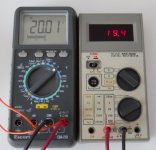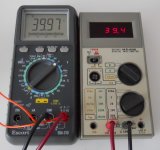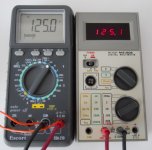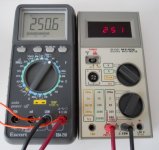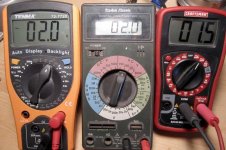Mooly, your results are better than I expected. Any idea what they would be like on 60Hz or 120Hz? I'll test mine on the 200V AC scale out of curiosity.
Here you go, this was at 60hz
Attachments
-
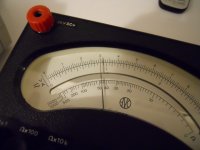 1. 3vac on 10 volt range (640x480).jpg194.8 KB · Views: 281
1. 3vac on 10 volt range (640x480).jpg194.8 KB · Views: 281 -
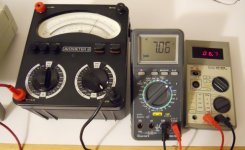 6. 7vac on 10 volt range (640x392).jpg203.8 KB · Views: 108
6. 7vac on 10 volt range (640x392).jpg203.8 KB · Views: 108 -
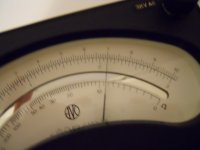 5. 7vac on 10 volt range (640x480).jpg172.2 KB · Views: 231
5. 7vac on 10 volt range (640x480).jpg172.2 KB · Views: 231 -
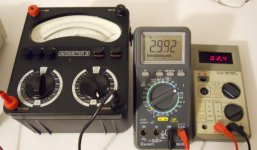 4. 3vvac on 3 volt range (640x374).jpg191 KB · Views: 244
4. 3vvac on 3 volt range (640x374).jpg191 KB · Views: 244 -
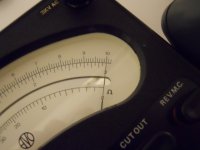 3. 3vac on 3 volt range (640x480).jpg176.8 KB · Views: 267
3. 3vac on 3 volt range (640x480).jpg176.8 KB · Views: 267 -
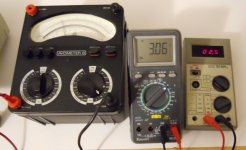 2. 3vac on 10 volt range (640x391).jpg194.2 KB · Views: 273
2. 3vac on 10 volt range (640x391).jpg194.2 KB · Views: 273
That LED DVM is not to be trusted! 😉 The other one does pretty well, doesn't it? Close enough for our tests, I think.
Just thinking about how loud is loud. In an orchestra, the loudest instrument is probably the timpani which could peak at 130dB @ 1m. If you were 16m away (from the timpani) in the audience, the peak SPL there would be 106dB. The peak (theoretical) SPL I can get at my listening position is 100dB, so I would be clipping occasionally if I tried to achieve that level. Not bad for 1W per channel.
Brian.
Brian.
Paul Klipsch went around the world for years claiming the world needs a good 10W amp. David Manley build one but K-horns still sounded like K-horns.
I used a 10 W class A amp in my office driving Paradigm Studio 20's for years. No problem. I recently changed from a 120W Hafler to a 60W Rotel on my subs, no problem. I run my mains on a second one. None of these are high efficiency. I have not got around to building a really high efficiency system yet like the Gedlee. I have a wonderful little Creek to drive it with.
I used a 10 W class A amp in my office driving Paradigm Studio 20's for years. No problem. I recently changed from a 120W Hafler to a 60W Rotel on my subs, no problem. I run my mains on a second one. None of these are high efficiency. I have not got around to building a really high efficiency system yet like the Gedlee. I have a wonderful little Creek to drive it with.
Measuring voltage across a speaker will not give an accurate representation of the amps power output since the speaker might say 8 ohms on its name plate, but it isn't 8 ohms. Somewhere I have some nice scope pictures showing nearly 40 volts peak to peak unclipped across the speaker terminals of my Yamaha NS-10M speakers. The amplifier is a Tubelab SSE which makes about 10 watts. How is this possible?
The CD playing had a solo bass guitar run that contained a lot of power in the 70 Hz range which coincides with the resonance of the woofer. The speakers impedance at this point is about 20 ohms. The amp will clip if I turn it up farther even though it is only making about 4 watts because it runs out of voltage headroom.
I have a pair of Audio Nirvana 10 inch full range speakers mounted in large horns. The efficiency is about 96db. I also have a pair of Hawthorne Silver Iris 15 inch coaxials mounted in a matching pair of 1941 vintage Zenith console radios. The efficiency is again about 96db.
I have several tube amps from 2 WPC to 125 WPC. Guess which one sounds the best on both sets of speakers with dynamic music? The big one of course! You can't turn it up loud and stay in the room, but it just sounds "effortless". I can open the windows, connect the Silver Iris, dime the volume control, and listen to music while mowing my lawn without hearing the lawnmower though.
The CD playing had a solo bass guitar run that contained a lot of power in the 70 Hz range which coincides with the resonance of the woofer. The speakers impedance at this point is about 20 ohms. The amp will clip if I turn it up farther even though it is only making about 4 watts because it runs out of voltage headroom.
I have a pair of Audio Nirvana 10 inch full range speakers mounted in large horns. The efficiency is about 96db. I also have a pair of Hawthorne Silver Iris 15 inch coaxials mounted in a matching pair of 1941 vintage Zenith console radios. The efficiency is again about 96db.
I have several tube amps from 2 WPC to 125 WPC. Guess which one sounds the best on both sets of speakers with dynamic music? The big one of course! You can't turn it up loud and stay in the room, but it just sounds "effortless". I can open the windows, connect the Silver Iris, dime the volume control, and listen to music while mowing my lawn without hearing the lawnmower though.
That's true, but I wasn't going to suggest people measure the current into the speaker, as getting most folks to measure the voltage is hard enough. One step at a time! 😀Measuring voltage across a speaker will not give an accurate representation of the amps power output since the speaker might say 8 ohms on its name plate, but it isn't 8 ohms.
120Hz works well for this as it's generally in a range where the impedance is pretty flat and close to nominal on most speakers. If the driver has wild dips and peaks, it can be harder to measure. Still, setting the level by ear then measuring a single tone at the same input level as the music works pretty well. This isn't an exact test, but that's not what we are aiming for. This is more - "Do I need 10W, 50W or 200W?"
That LED DVM is not to be trusted! 😉 The other one does pretty well, doesn't it? Close enough for our tests, I think.
Yes, the LCD one seems pretty decent.
I'll have to compare the two DVM's on higher voltages and mains next 🙂
That LED DVM is not to be trusted! 😉 The other one does pretty well, doesn't it? Close enough for our tests, I think.
Pano, as you say "not to be trusted".
These pictures are self explanatory with range settings shown. Voltages were measure on a transformer secondary and primary tappings... compare the readings of the two DVM's with these higher voltages.
It shows that unless proved otherwise do not assume your DVM is accurate on low level AC even if it is a sine wave and even if it is within the frequency range of the meter.
Attachments
Mooly,
if we assume that the "escort" is absolutely accurate +-0.005%, then the errors in the Soar are from left to right.
-3%, -1.4%, +0.08%, +0.16%
Some of these readings are right down to the least significant digit. Read the spec for the DMMs. What is the +- tolerance of the different AC scales? What is the least significant digit tolerance? What is the source impedance of the voltage being tested? What is the input impedance of the meter taking the readings?
What is the problem you are showing?
if we assume that the "escort" is absolutely accurate +-0.005%, then the errors in the Soar are from left to right.
-3%, -1.4%, +0.08%, +0.16%
Some of these readings are right down to the least significant digit. Read the spec for the DMMs. What is the +- tolerance of the different AC scales? What is the least significant digit tolerance? What is the source impedance of the voltage being tested? What is the input impedance of the meter taking the readings?
What is the problem you are showing?
If I were taking music signal averages with a cheap DMM set to the 199.9mVac scale and I was seeing the readings fluttering about between 70mVac +-30mVac, i.e. from 40m.1mVac to 99.9Vac , would I care that a -3% error would give a ~-6% error in the estimated average power?
You can be damn sure I don't care.
What can I do about the +-3% DMM?
I would compare my DMMs. I have two 2000 count DMM that average ac and then scale to the readout. I have one benchtop 50000 count DMM that reads true rms over a specified range. I have two oscilloscopes that corroborate Vrms to Vpk/Vpp.
I can with some probability what the accuraies are of eachof the meters in comparison to each of their specified tolerances.
I cannot see how a meter that is specified as +-0.5% +-1 digit on the 199.9mVac scale when new and has wandered to double that tolerance range in it's old age will make my house burn down or damage my ears.
You can be damn sure I don't care.
What can I do about the +-3% DMM?
I would compare my DMMs. I have two 2000 count DMM that average ac and then scale to the readout. I have one benchtop 50000 count DMM that reads true rms over a specified range. I have two oscilloscopes that corroborate Vrms to Vpk/Vpp.
I can with some probability what the accuraies are of eachof the meters in comparison to each of their specified tolerances.
I cannot see how a meter that is specified as +-0.5% +-1 digit on the 199.9mVac scale when new and has wandered to double that tolerance range in it's old age will make my house burn down or damage my ears.
Last edited:
Thanks for the double check, Mooly. The LED meter does a lot better at higher voltages. That's why I have suggested not using a 200V scale for these tests - you can't be sure of the readings. On a 20 VAC scale, things will be a lot closer.

That does not even make sense.Thanks mooley, i guess this is where most are getting their 2 watt ratings ...

Mooly,
if we assume that the "escort" is absolutely accurate +-0.005%, then the errors in the Soar are from left to right.
-3%, -1.4%, +0.08%, +0.16%
Some of these readings are right down to the least significant digit. Read the spec for the DMMs. What is the +- tolerance of the different AC scales? What is the least significant digit tolerance? What is the source impedance of the voltage being tested? What is the input impedance of the meter taking the readings?
What is the problem you are showing?
Hi Andrew,
There's no problem, it just came about discussing possible inaccuracy of meters (or lack of) at low AC voltages after I posted a pdf on my AVO calibration.
The DVM's and AVO in all the tests were run in parallel so source impedance doesn't affect the readings which in the last tests was mains and transformer secondaries. It is pure luck the tranny gave just under 40.00 volts as that coincided with the 40 Vac range on the escort meter.
The SOAR manual was mislaid some years ago (it's around 30+ year old now) and the escort was an "aquisition" from a colleague.
Thanks for the double check, Mooly. The LED meter does a lot better at higher voltages. That's why I have suggested not using a 200V scale for these tests - you can't be sure of the readings. On a 20 VAC scale, things will be a lot closer.
You're welcome.
The SOAR officially doesn't have a 20Vac range, just the 200 and 600 volt. Personally I tend use a scope for all audio measurements with a claculator alongside 😉
Is a "claculator " another name for an abacus ;^)?You're welcome.
The SOAR officially doesn't have a 20Vac range, just the 200 and 600 volt. Personally I tend use a scope for all audio measurements with a claculator alongside 😉
Inspired by your meter check I did my own shown here. Actual voltage is 2.08V AC 120Hz.
Any higher and the Tenma and Radio Shack showed 2.1V. Any lower and the Craftsman shows 1.4V All on the 200V AC scale.
Not surprising that the Craftsman is off. It's a $30 meter designed for much higher AC voltages. As the voltage drops, it's farther and farther off. The other two work just fine for general audio use up to about 1Khz
Any higher and the Tenma and Radio Shack showed 2.1V. Any lower and the Craftsman shows 1.4V All on the 200V AC scale.
Not surprising that the Craftsman is off. It's a $30 meter designed for much higher AC voltages. As the voltage drops, it's farther and farther off. The other two work just fine for general audio use up to about 1Khz
Attachments
Is a "claculator " another name for an abacus ;^)?
That's the one 😉
Next to the claculator is my parchment and quill for recording said readings 🙂
Inspired by your meter check I did my own shown here. Actual voltage is 2.08V AC 120Hz.
Any higher and the Tenma and Radio Shack showed 2.1V. Any lower and the Craftsman shows 1.4V All on the 200V AC scale.
Not surprising that the Craftsman is off. It's a $30 meter designed for much higher AC voltages. As the voltage drops, it's farther and farther off. The other two work just fine for general audio use up to about 1Khz
Great to see another comparison like that, thanks.
Because I never normally use a DVM for signal measurement it's something I never gave any thought too. Some folk are going to get misleading readings following my method in the other thread if they have a meter like these.
2 volts at 4 ohm =1 watt
1.4 volt at 4 ohm = 0.49 watt
Massive error... eek !
- Status
- Not open for further replies.
- Home
- Loudspeakers
- Full Range
- High efficiency speakers - how much power do they really need?
